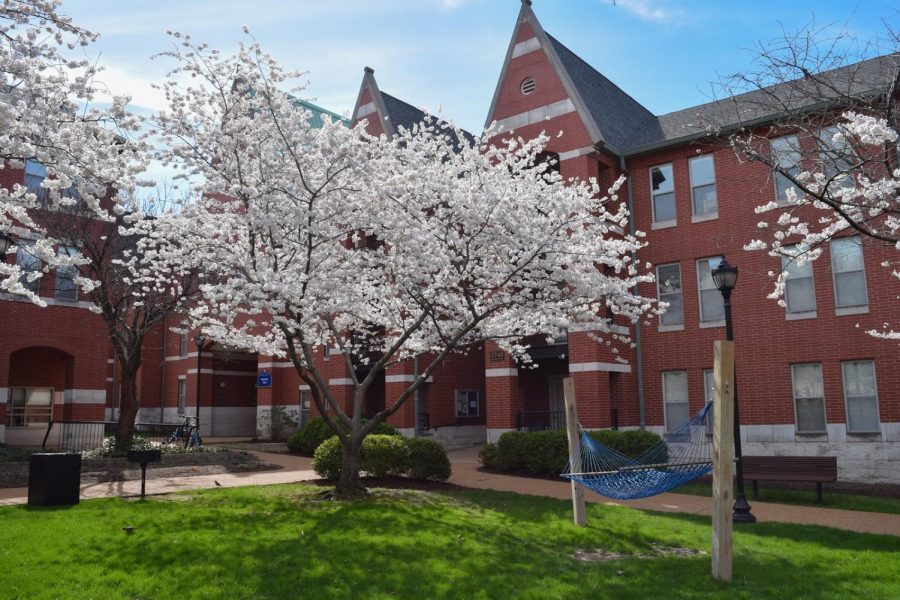SLU Implements Consolidated Housing Plan in Response to COVID-19
In late March, SLU unveiled a consolidated housing plan in order to combat the spread of COVID-19 on campus and to provide relief to healthcare employees and patients nearby. Under this housing plan, students living in residence halls who chose “standard precautions” housing were moved to Spring Hall while students living in on-campus apartments were moved to Marchetti Towers. Additionally, students who chose “advanced precautions” housing were moved to Grand Hall while students living in Robert May Hall were not forced to relocate. “Standard precautions” housing is aligned with St. Louis’ stay-at-home order while “advanced precautions” housing includes coordinated efforts to minimize face-to-face interactions during essential activities beyond what is required by the city’s stay-at-home order.
The remaining residence halls and on-campus apartment complexes will be reserved for the needs of the St. Louis region. This would mostly include serving as temporary living quarters for medical staff and overflow space for hospital patients. SLU stated on the university’s website that they are working closely with SLUCare physicians, SSM Health physicians and administrators and public health efforts in the region to determine the best use of the residence halls as the virus spreads. SLU also noted that they designed a plan which separates these spaces from the reconsolidated spaces in which the students live.
Students who filled out an exemption request were required to live in Spring, Grand or Marchetti depending on their spring 2020 housing status and their preferred precaution level. However, students who did not receive approval for an exception to remain on campus were expected to move out by March 30. This deadline ensured that all eligible students would receive refunds for room and board.
In order to limit COVID-19 infections on campus, SLU has instituted a set of guidelines for the remaining students on the consolidated housing plan. No students will share living quarters, including apartments, even if the space has multiple bedrooms. There are no non-SLU visitors allowed in on-campus housing whatsoever. Additionally, there are no building-to-building visitors allowed on campus. The only exception to this is the Grand Hall dining space, where 10 or fewer students can congregate as long as they meet social distancing requirements. Room-to-room visits within a building also should be done in accordance with social distancing expectations. The spaces SLU designated for students who contract COVID-19 have been chosen to allow the least amount of exposure for students, faculty and staff. These spaces all come with thoughtfully designed plans on facilities needs, housekeeping needs and food and supply needs. Students suspected of or confirmed having COVID-19 will have to temporarily relocate from their assigned housing unit until medical experts agree it is safe for them to return to their dorms or apartments.
Throughout this unprecedented pandemic that led to the implementation of the consolidated housing plan, students remaining on campus have faced some challenges. Junior Xander Sisco was in Marchetti East for his spring housing assignment and said the process for him to stay in that same apartment for consolidated housing was “really stressful.” The fact that Sisco had to get approved in order to stay on campus also made things more challenging for him. “Not knowing if I had to move for several weeks also added a ton of stress,” said Sisco. Sisco also had some concerns about consolidating students down into a few buildings. He thought this could potentially maximize contact between students on campus. SLU’s plan to address these types of concerns was to spread students out in on-campus housing. In this case, no building is operating at more than 50 percent capacity. Additionally, the consolidated housing plan states that at any time, the spread of the virus may require SLU to increase restrictions for both housing groups in consultation with or at the order of public health authorities.
According to Lauren Davis, Assistant Director of Assignments and Marketing of SLU’s Housing & Res Life, the consolidated housing plan was a university-wide collaboration between multiple departments and the president’s office to “ensure the best decisions were made for our students, staff working within the halls, and the greater good of the community.” Davis clarified that the decisions regarding the buildings that would not be used by university housing during COVID-19 were made at a university and SSM level.
There are currently around 250 students remaining on campus through the consolidation plan. Davis said that each is in their own space with their own bathroom “in order to have the ideal social distancing structure.” In terms of meal plan options, Davis said that all dining is grab and go and “self-serve” stations were eliminated in order to help flatten the curve. In order to lower risk of infection in SLU buildings, Davis said facilities and custodial services have been following a rigorous cleaning routine, adhering to CDC guidelines and guidelines from the university health center.
In regard to the on-campus housing situation for the summer semester, Davis said, “It is a touch and go situation as we monitor the changes and updates of COVID-19 while also complying with state governing orders.”
For further details on SLU’s consolidated housing plan, visit The Housing Information page on the university’s website.
Your donation will support the student journalists of Saint Louis University.




